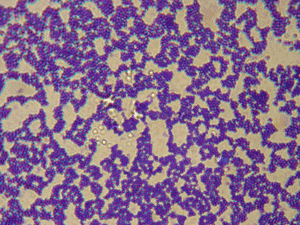Microbial Composition Of Sludge

A large amount of Solid/Water and Biosolid Waste is generated all around the world as a result of various activities. Such waste is treated before it is released into the environment. Effluent is the treated waste and sludge is the raw waste.
Digesters are large fermentation tanks where anaerobic digestion of raw waste/sludge takes place. They are provided with mechanical mixing, heating, gas collection, sludge addition / withdrawal ports and supernatant outlets. Anaerobic digestion consists of a series of microbiological processes that convert organic compounds to methane gas (which is used as a biofuel), water and other solids. It has long been used for the stabilization of waste/wastewater sludge. Consortia of microorganisms, mostly bacteria, are involved in the transformation. Although the raw sludge contains a variety of pathogenic bacteria, dominating groups are the E.coli, fecal Coliforms, Pseudomonas, Bacillus, Staphylococcus, Hydrolytic bacteria, Acidifying bacteria, Methanogenic bacteria and other anaerobes.
Microbial Analysis Of Sludge
Sludge microbial analysis and enumeration gives an idea of the level of biodegradation. Efficiency of the digester can also be judged and quality of the effluent can be predicted. Comparison of microbial analysis prior to and after treatment helps improvise on plant performance. It also indicates whether there is a significant reduction in the number of pathogenic bacteria in the digester and hence the digested material so that when the biotreated waste is released in the environment, it is safe enough and has no adverse environmental impact or of health concerns to human/animal health.
BioAerosol
Bioaerosols are airborne particles partially or exclusively composed of microorganisms including bacteria and fungi. Bacteria and fungi present in composting sites, organic materials, municipal solid wastes, oil industries and other similar work environments may become airborne as dusts during processing.
BioAerosol Composition, Sampling And Analysis
Sampling and analysis of airborne bacteria and fungi in industrial /other environments is used to determine the health significance of these microbiological aerosols. Exposures to bioaerosols in the occupational environment are associated with a wide range of health effects with major public health impact, including infectious diseases, acute toxic effects, allergies and cancer. Respiratory symptoms and lung function impairment are the most widely studied and probably among the most important bioaerosol-associated health effects.
Bacteria like Fecal coliforms, Klebsiella species, Staphylococcus aureus, Pseudomonas sp., Bacillus sp. and Fungi like Aspergillus sp, Penicillium sp and others that are hazardous to health are tested for.
Methods Of Testing
Standard methods such as those of ASTM are recommended.
Should you have a question concerning microbiological tests for digester sludge contact Mold & Bacteria Consulting Laboratories at 905-290-9101.